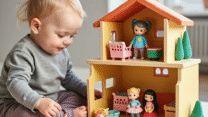
How To Build Daily Routines in Toddlers (Without Battles or Burnout)
Introduction: Toddlers Thrive on Routine—Even If They Fight It

If you’ve ever tried getting your toddler dressed, fed, and out the door without at least one meltdown—you know the struggle is real.
But here’s the secret: toddlers don’t hate routines. In fact, they crave them. Predictability gives them a sense of security, helps reduce anxiety, and lays the foundation for self-regulation.
And you don’t need a military schedule. You just need gentle, age-appropriate structure that fits your life and supports theirs.
Let’s dive into how to build daily routines that actually work—for both of you.
Why Routines Matter So Much for Toddlers
- Brain Development: Repetition strengthens brain pathways. Daily routines help toddlers understand what comes next, which supports learning and behavior.
- Emotional Security: When toddlers know what to expect, they feel safe. That reduces power struggles and improves cooperation.
- Less Chaos for You: With routines in place, you spend less time negotiating, reminding, and repeating—and more time enjoying your child.
Step-by-Step: How to Build Gentle Daily Routines for Toddlers
1. Start With the Big Anchors
Focus on the 3 core parts of a toddler’s day:
- Wake-up & morning routine
- Meal and snack times
- Bedtime & wind-down
Start by building consistency around these. Everything else can be more flexible.
Example Morning Routine:
- Wake up & cuddle (connection first!)
- Use the potty/diaper change
- Get dressed
- Eat breakfast
- Brush teeth
- Pick one toy/book before starting the day
2. Use Visuals to Make It Tangible
Toddlers are visual learners. Use routine charts with pictures so they can “see” what’s next.
Even a simple printable with photos or symbols can work wonders.
“I made a little chart with my 2-year-old’s face next to his toothbrush and pajamas—and suddenly bedtime became fun!”
You can even let your toddler help choose the order for non-negotiables. That gives them a sense of ownership.
3. Connect Before You Direct
Before giving instructions, connect emotionally:
- Use eye contact
- Get down to their level
- Offer a quick cuddle or gentle touch
This prevents resistance before it starts and reminds them: you’re a team.
4. Use Gentle Transitions and Cues
Sudden changes = toddler chaos.
Use signals and verbal cues:
- “After this puzzle, we’ll put on shoes.”
- “Let’s sing the cleanup song together.”
- “When the timer beeps, it’s snack time!”
Toddlers respond well to rituals and routines around transitions, like singing a song before brushing teeth or ringing a bell before lunch.
5. Expect Pushback (And Stay Consistent)
Your toddler will test the routine—because testing is learning.
Stay calm. Stay consistent. Say:
“I know you don’t want to brush teeth right now. But it’s part of our bedtime steps.”
The more you stay steady, the more secure they’ll feel—even if they don’t show it at first.
6. Make It Fun and Playful
Toddlers live through play. So build play into routines:
- Race to the bathroom
- Sing while brushing teeth
- Pretend their pajamas give superpowers
Play reduces resistance and builds positive associations.
Sample Toddler Routine: Age 1–3
Here’s a gentle structure that can be adapted to your child’s needs:
| Time | Activity |
|---|---|
| 7:00 AM | Wake up, snuggles, diaper/potty |
| 7:30 AM | Breakfast |
| 8:00 AM | Brush teeth, get dressed |
| 8:30 AM | Free play / Outdoor time |
| 10:00 AM | Snack |
| 10:30 AM | Storytime / Sensory play |
| 12:00 PM | Lunch |
| 12:30 PM | Nap or quiet time |
| 2:30 PM | Wake up, snack |
| 3:00 PM | Play / Walk / Simple activities |
| 5:30 PM | Dinner |
| 6:30 PM | Bath time |
| 7:00 PM | Pajamas, brush teeth, bedtime story |
| 7:30 PM | Lights out |
Don’t worry about sticking to exact times—follow the flow, not the clock.
What If We’re Busy or On-the-Go?
You can still keep routines, even during chaotic or travel days.
– Stick to key anchors (like meals and bedtime rituals)
– Bring a comfort item or familiar book
– Use verbal routines (“After this, we’ll…”)
-Adjust expectations—don’t aim for perfect, aim for connection
Real Talk: When Routines Feel Like a Lot
Some days, even brushing teeth feels like climbing a mountain. That’s okay.
If you’re overwhelmed:
- Start with one small routine (like bedtime)
- Keep it super simple
- Celebrate small wins
- Give yourself grace
This isn’t about control—it’s about creating rhythm and safety for your child and for you.
Final Thoughts: Gentle Structure Builds Confidence
Daily routines help toddlers feel capable, calm, and connected. You’re not just getting through the day—you’re giving them tools for life: independence, emotional regulation, and trust in the world around them.
Even if it’s messy, even if they resist, even if you forget half the time—you’re doing it. One gentle, loving step at a time.
SHOP NOW!
Optional Freebie for Readers:
Free Download:
Printable Toddler Routine Chart (Morning + Bedtime)
Includes visual icons, blank versions to customize, and tips for use.
Toddlers thrive on routines—but let’s be ho













